Сельскохозяйственные науки. Рубрика в журнале - Бюллетень науки и практики

Prevalence, treatment and prevention of ascariasis in turkeys
Статья научная
Ascaridiosis in turkeys is a parasitic disease caused by Ascaridia galli , one of the most prevalent helminth infections in poultry. This disease is particularly widespread among turkeys raised in semi-intensive or free-range systems and leads to decreased productivity, stunted growth, weakened immunity, and economic losses. Clinical signs include loss of appetite, weakness, poor feather condition, diarrhea, and growth retardation. In severe cases, it can result in mortality. Diagnosis is mainly based on microscopic examination of feces, where characteristic Ascaridia galli eggs can be identified. Necropsy of deceased birds may reveal large, white worms in the intestines, confirming the diagnosis. Treatment involves the use of broad-spectrum anthelmintic drugs such as albendazole, fenbendazole, levamisole, and piperazine, which are administered through feed or drinking water in specific doses. Correct dosing and treatment duration are essential for effective control. Preventive measures include regular disinfection of cages and equipment, maintaining hygienic and dry conditions, ensuring clean feed and water, and conducting periodic veterinary monitoring. Prophylactic deworming every 3-4 months is recommended to reduce infection risk. This study highlights the biology, epidemiology, clinical presentation, diagnosis, treatment, and prevention of ascaridiosis in turkeys, emphasizing the importance of early detection and control to maintain flock health and productivity.
Бесплатно
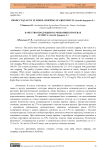
Product quality in mixed cropping of groundnuts (Arachis hypogaea L.)
Статья научная
The article notes that the groundnuts crop yield in mixed cropping is the result of a combination of plant growth and development, photosynthetic activity, biomass harvesting and other aspects of increasing crop performance in specific soil and climatic conditions and depends on agricultural practices. In indoor practice, it has been found that the use of mixed cropping not only increases crop performance, but also improves crop quality. The amount of oil contained in groundnuts seeds, along with fast growing tomatoes, increased by 2.7% compared to groundnuts sole cropping. When sowing groundnuts with potatoes, a slight decrease in oil content was observed (49.5%). The content of proteins in this variant decreased by 2.4-1.5% compared with groundnuts sole cropping. The quality of potato tubers, including the amount of starch, changed in mixed cropping. When mixed cropping groundnuts and potatoes, the starch content in potato tubers increased to 25%. The quality of the tomatoes has also changed. The amount of vitamin C contained in medium and early ripening tomato varieties increased to 17.3-17.9 mg/%. This is 0.6-0.9 mg/% higher than on tomato sole cropping.
Бесплатно
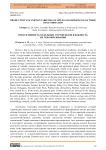
Productivity of certain varieties of apples and importance of their gene formation
Статья научная
Due to the diversity of its natural and historical conditions, Azerbaijan is one of the centers of the initial formation of many plants, having a great genetic richness of the plant world. A large number of valuable varieties and forms of food and agricultural plants have been created through folk selection and scientific selection, with the history of agriculture covering several millennia. However, massive and anthropogenic disturbances of all these natural and cultural heritage ecosystems, which are the irreplaceable wealth of the people, created a large number of valuable varieties and forms of ecological and agricultural plants. However, all this natural and cultural heritage, which is the irreplaceable wealth of the people, is threatened with destruction as a result of mass and anthropogenic disturbances of ecosystems, ecological and agricultural changes, and the wide application of modern breeding achievements. In addition to all this, the study, protection, and effective use of the gene pool of the apple plant in the country is one of the main factors. In this regard, based on our long-term research, with the efficient use of the gene pool of the apple plant in Azerbaijan, new “spur”-type selection varieties (Nigar, Ziya, Zirva, Marfa, Sulh, Gobustan, Zumrud, Kyzyld Taj, Khazar, Eldar, Ulvi, Nübar, Vatan, Makhmari, Nuran, Sarvan, Chiraggala, Davamli, Emil, Elvin, Paizliq Guba, Zizliq Guba, Shabran, Sadaf and Sevinj) were created by us. In the article, the parental pairs of those cultivars are reflected in the ripening period, ripening, fruiting periods, tree parameters (height, diameter of the umbel, circumference of the stem), productivity indicators, leaf surface, infection rates of scab disease, average mass of fruits and tasting prices. At the same time, the article contains the introduction, research conditions, methodology, material, results, discussion, recommendations, and used literature sources.
Бесплатно
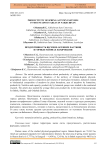
Productivity of spring-autumn pastures in mountainous areas in Nakhchivan
Статья научная
The article presents information about productivity of spring-autumn pastures in mountainous areas of Nakhchivan. Meadows of the territory of Günnut-Kapicik physical-geographical region, species composition and structure of multi-grass formation, indicators related to biochemical composition of meadows by plant formations, area of meadows by formations, productivity, Nutrition and capacity, productivity by botanical groups were studied in the conducted research. The article also studied the average three-year productivity in the main botanical groups for Babek, Shahbuz, and Ordubad districts.
Бесплатно
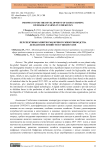
Prospects for the development of dairy farming of dekhkan farms in Uzbekistan
Статья научная
The global temperature rise, which is increasingly noticeable on our planet today, the global financial and economic crisis in the background of the COVID-19 pandemic, the demographic situation in various countries has a significant impact on all sectors of the economy, especially agriculture. The full satisfaction of the population’s needs for high-quality and cheap livestock products of local production depends mainly on measures for the development of dekhkan farms, which, in turn, requires the introduction of modern and innovative methods in this industry. The purpose of the study is to identify current problems in dekhkan dairy farms based on the analysis of statistical data for the period 2017-2021, as well as scientific research. Based on the results of the analysis, give practical proposals for the further development of dekhkan farms through the introduction of modern digital technologies. A digital mobile system created to provide services to dekhkan farms in the production of milk will be tested in dekhkan farms of the regions of the Republic of Uzbekistan and, on the recommendation of the relevant state organizations, put into practice.
Бесплатно
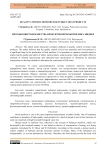
Quality control methods for turkey meat products
Статья научная
The article under discussion considers methods of quality control of turkey meat products. The author believes that the quality control of food raw materials and food products is a significant stage in the production of food products. It is important to organize research aimed at improving the quality and safety of turkey meat products, using accurate, rapid, and highly effective methods of infrared spectroscopy and chromato-mass spectrometry to determine its chemical composition to develop methods to determine the correctness of HS codes.
Бесплатно
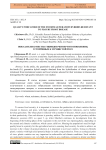
Quality indicators of the fourth generation hybrids resistant to floury frost disease
Статья научная
In the article, the quantitative and qualitative indicators and correlations between the fourth (F4) generation hybrid samples obtained from the hybridization of wheat genotypes introduced from international centers and local varieties selected for their resistance to diseases and distinguished by high quality indicators were studied.
Бесплатно
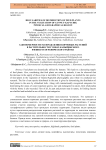
Статья научная
Feed plants are dynamically utilized by humans. This leads to a decreasing supply of feed plants. Also, considering that feed plants are eaten by animals, it can be observed that the decrease in the supply of these crops is inevitable. For this purpose, we studied the rare species of feed plants in the vegetation of Gunnut-Kapychik physiographic area where we conducted our research. The list of rare species distributed in the area is given by determining the distribution of feed plants in the area by altitudinal belts. Along with internationally recognized categories for determining the status of some important species, rare and endangered in nature, their relationship with the biome is also recorded. First of all, its past and present state in nature, its limiting factors are clarified and included in one of the relevant categories.
Бесплатно
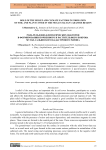
Статья научная
Collected and analyzed data on soil, ecological, climatic and relief conditions of the Mugan-Salyan cadastre region. The study of relief-climatic factors in the formation of soil and vegetation was carried out on the basis of both literary sources and our own research.
Бесплатно
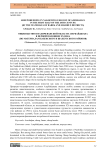
Статья научная
Azerbaijan is known as one of the oldest sheep breeding countries. The natural and geographical conditions of Azerbaijan had a special impact on the creation and development of animal husbandry, especially sheep breeding. At that time, the tribes living in Azerbaijan were engaged in agriculture and cattle breeding, which led to great changes in their way of life. During this period, although people lived collectively, the main place in cattle breeding, especially in caring for it and feeding it, was occupied by men. In 1953, the animal breeders of the Nekhram village of the Nakhchivan (Babek) district purchased 2618 lambs from 2580 ewes. In general, based on the materials of the Babek and Shahbuz districts of the Nakhchivan region, it can be seen from the studies of the first half of the 20th century that, although for certain reasons there were certain difficulties in the development of sheep breeding in these districts until the 1920s, great success was achieved after 1920 with the creation of favorable conditions, success was achieved, and sheep breeding played a large role in meeting the financial needs of the population.
Бесплатно
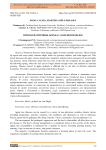
Signs, causes, fighting apple diseases
Статья научная
Numerous diseases often damage apples in home orchards each year. These include fly agaric and sooty mold, summer blight, black rot, powdery mildew, and cedar apple rust. This article discusses the signs, causes, progression, treatment, and preventive measures for several apple tree diseases. Some infections attack the tree roots in the fall, but symptoms do not appear until the following spring, when the tree can no longer absorb enough water and nutrients to continue growing. Disease control in apple orchards is difficult due to the lack of effective chemical treatments. Preventive measures can help control these diseases.
Бесплатно
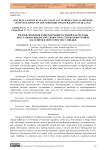
Статья научная
Negative factors caused to erosion and other natural and anthropogenic factors in the vegetation on the territory of river basins near Ganja have been mentioned in the article. Soil reclamation by plants measures have been advised for revegetation. It has been considered restoration of basically taproot system of trees, shrubs and herbaceous plants in degraded plots of land through reintroduction. For that, up to 60 plant seeds have been sown in 18 polluted and degraded plots of land.
Бесплатно
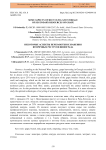
Some aspects of recycling and storage of secondary resources of grape
Статья научная
According to the National Wine Agency, grape harvesting in Georgia exceeded 231 thousand tons in 2018. Vineyards are not only growing in Kakheti and Racha-Lechkhumi regions, but in almost every area of viticulture. In the process of primary grape harvesting and wine production, up to 25% waste is generated by solid parts of the grape bunches (bunch, skin, grape seed) and emptying, which are the best raw materials for making the curing-preventive powder, extracts, syrups, concentrates, pills, granules, alcohol, wine acid, grape seed oil, grape seed flour, nutriment paints, pectin, food fiber, tannin, granulated feed-stuff, the animal nutrition silage, fertilizers, etc. for the production of many other precious products. Therefore, it is more relevant to study the optimal technologies of recycling of secondary resources of thousands of tons of grape.
Бесплатно
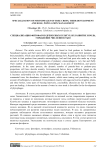
Specialization of phytophages of tree crops, their development and role, population management
Статья научная
The article discusses 80% of pests found in the orchards of Tashkent and Samarkand regions, their species composition, damage to trees and their parasites, as well as their populations, which cause particularly significant damage here. The number of predatory and parasitic entomophages is a major area of study. Environmental factors have a sufficient impact on the reproduction and development of forests. Due to the high relative humidity of the air, this environment becomes unfavorable for the development of certain insect species. In the forest, on ornamental trees, there is an abundance of natural insects that cause the destruction of plants. In this case, pests are leading. A decrease in the amount of water in a tree trunk is favorable for the development of phytophages.
Бесплатно
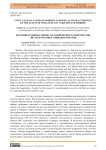
Статья научная
This article has been investigated and evaluated by studying the specification of anatomical structure of the sort samples of tomatoes. Studies have shown that anatomical indicators mainly have a great importance in learning of drought resistance, determining the origins of the different varieties, choosing of hybrid plants in selection work of the size and number of stomata, and total thickness of the leaves. Studying of anatomical characters of tomato sort samples and hybrids plants has shown that learning of the total thickness of the leaf and the size of number of stomata has a certain importance in selection of hybrid plants. It is defined that in sort samples which their cuticle layer is thick, water evaporation decreases, and they become resistible to illness. So, the sample of Volgograd 5/95, 82 and 90 in upper epidermis and the sample of 93 in lower epidermis were differed for the thickness of cuticle layer. As results of studies, it has been identified that chlorenchyma present in the sort samples predominant for differing according to the total thickness of the leaf. Moreover, studying of the leaf cells has shown that the evaporation of water is higher in the leaves which the number of stomatas is more, and the epidermis cells are few, for that reason, the leaves of Solanum pimpinellifolium L. (wild form) are in thin needle shaped in order to reduce the transpiration. Exactly for this reason, it’s recommended to use the wild form as a donor in conducting the future selection work.
Бесплатно
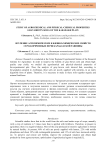
Study of agrochemical and physical-chemical properties gray-brown soils of the Karabakh plain
Статья научная
Research is conducted at the Terter Regional Experimental Station of the Research Institute for Agriculture. In order to improve the fertility of gray-brown soils and obtain high-quality crop yields, we studied the agrochemical and physical-chemical properties of the experimental plot. Thus, the analysis of gray-brown soils showed that, according to the gradation adopted in Azerbaijan, these soils are poorly supplied with nutrients, in an easily digestible form of plants. Therefore, it is necessary to make in these soils together organic and mineral fertilizers.
Бесплатно

Статья научная
Rumen Protozoa are strictly anaerobic and highly specialized ciliates and can live only in the rumen and similar habitats. These Ciliata play an important role in feed utilization and indicate the environmental impact (methane emissions and nitrogen excretion) of ruminant production. Digestion of feed in ruminants depends on the life activity of microorganisms. Without their help, ruminants could not assimilate cellulose with simple non-protein compounds. These microorganisms located in rumen decompose the organic substances in the feed and form volatile fatty acids, ammonia, amino acids, which animals use for their development and reproduction. In the rumen of domesticated cattle and sheep, rumen cilia constitute 20-50% of the total microbial biomass. Rumen Ciliata develop symbiotic relationships with their animal hosts and both symbiotic and predator-prey relationships with other members of the rumen microbiota. The lack of axenic cultures of rumen Ciliata has forced researchers to use other methods to determine the metabolism and functions of rumen Protozoa, such as comparing rumen fermentation and microbial profiles of faunal and non-ciliated cattle or sheep or using in vitro cultures.
Бесплатно
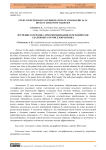
Study of heterosis in hybridization of geographically distant gossypium varieties
Статья научная
In the study, hybridization was carried out between the local Gossypium variety and geographically distant Gossypium varieties to obtain a selection starting material. To determine the effect of heterosis, hybrids obtained from the crossing of Ganja-110 Gossypium variety with geographically distant cotton varieties were studied, F1 generation hybrids showed a positive dominance in terms of growing season. The fiber yield of F1 hybrids of Ganja-110 × Selekt hybrid combination was the dominant hereditary character. In F1, the mass of raw cotton obtained from one cocoon was close to the parent form with a larger cocoon in hybrids obtained for all combinations. F1 hybrids were superior in fiber length compared to their parent forms. In the F1 hybrid offspring, all combinations were close to the parent form with high fiber length. The individual samples collected according to the characteristic shown in F3 were higher than the parent form, and sometimes closer to the parent form with higher fiber length. The individual samples collected from the hybrid seeds studied in the experiment were quite effective.
Бесплатно
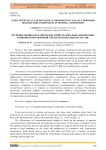
Статья научная
The study highlights the relevance of creating a mechanized and automated local power-mixed feed production area that ensures the efficient use of complete ration mixed feeds. The object of the study was to create an efficient production area based on the use of local feed base and imported feed additives, microelement feed complex, dosage and mixing of complete ration feed components, their physical and mechanical properties and their effect on the quality indicators of the process. The results obtained allow us to select appropriate operating modes to avoid a decrease in mixing quality when an increase of more than 20% of fillers in complete feed is required.
Бесплатно
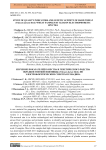
Статья научная
According to statistical indicators, wheat takes major part of food ration of people. It is raw material for preparing food products such as macarons, tandir bread etc. Under different environmental conditions it is important to develop wheat biotypes with high genetic diversity and variety is a biological factor that has strong influence on obtaining a high-quality product. The research aim is to define technological and biochemical indicators of hard wheat ( Triticum durum Desf.) genotypes and prolamin markers, to identify and passport reserve proteins of gliadin and gluten. It is appropriate to ensure the selection of existing genotypes by determining gliadin-encoding loci, which are considered markers of certain economically important traits. Overall were used 41 samples. Most of the samples had high vitreousness ranging between 84% and 100% which was determined in OLIS D3-3 diaphanascope. The amount of wet gluten was determined in KDI-1 apparatus. Grain moisture content was determined using a GAC 2100 Grain Analysis Computer. 9 samples were selected due to high-quality indicators. Polymorphism of gliadin resource proteins was electrophoretically analyzed on a polyacrylamide gel (Acid-PAGE) and based on the diversity of 4 zones (ω, γ, β, α) distinguished as a result of the analysis of the obtained electropherograms, 0-1 operation was performed, and the genetic diversity index was calculated. Based on results, it is more applicable to consider the allelic blocks of the gliadin-encoding loci related to quality, adaptability and productivity traits.
Бесплатно

